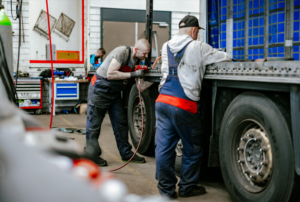Parts availability and technician shortages, the two issues that have plagued commercial fleets and repairers for the last three years, have improved in 2023, as shown by the r2c vehicle off-road (VOR) data.
r2c’s system allows fleets and workshops to record the reason the vehicle is off-road and the number of days. Consequently, it can shine a light on trends in maintenance and repair by comparing data for different periods.
r2c’s figures, based on more than 30,000 records across accident damage and unscheduled repairs, show that there has been a general improvement across the board when it comes to delays as a result of parts availability and shortage of labour – two issues that have plagued the SMR sector for the past few years.
Records of unscheduled delays due to a lack of parts show that, on average, the number of days off the road have dropped from 16 in 2022 to 11 in 2023. However, Debbie Fox, managing director of r2c, says that this is still a high figure and that fleets and repairers can reduce this further.
Debbie said: ‘A week-and-a-half to two weeks off the road because fleet managers can’t source the right parts is still too high. We’re seeing that the general level of parts is higher now, so what this means is many fleets need to employ better stock management processes.
‘Often delays occur simply because the part exists but is in the wrong place or depot and can’t be found or moved. With r2c’s stock management system, fleets and workshops have much better visibility of what they already have on hand and, crucially, where it is being stored. It enables them to get the part to the right location far quicker. But as the figures show, parts availability is still a hugely critical element of VOR.’
The other major problem in recent years, labour and technician shortages, can also be measured in r2c’s system, and there has been a slight drop in unscheduled delays due to workforce problems, down from 16 in 2022 to 14 now.
While movement in the right direction is to be welcomed, Fox says two-week delays because there is nobody to do the job is still unacceptable and suggests that the industry still needs to be able to solve the problem. Instead, it is time to find other solutions.
She added: ‘Any fleet operators who have had vehicles sitting in a compound, unable to be worked on because there is nobody to do it, will know the frustration, hassle and cost this causes. And for all the best efforts of industry bodies and repairers, it will take a while to ramp up the workforce to a level operators require.
‘So instead, it’s time to look for other solutions. One of the critical elements of this data is that the work we’re talking about is unscheduled. There may not be much you can do regarding breakdowns, but it’s essential to ensure that you’re covering every other possible problem and spotting it before it takes the vehicle off the road.
‘That’s where a rigorous driver check system provides a huge benefit. Suppose vehicles are being inspected thoroughly every day. In that case, we tend to find that unscheduled problems become scheduled – and these planned events place far less stress on the repair network, its technician capacity and parts availability, and the positive trend we’re currently seeing should improve further still.’
Further analysis of the r2c data shows significant improvements in VOR for unscheduled work delays for MoT-related issues, down from an average of 33 days in 2022 to 23 in 2023 YTD, and a substantial reduction in delays with insurance company authorisation for accident damage, reducing from 65 days to 18.
‘Through the r2c system, we’ve seen workflow freeing up in many operationally critical areas of SMR this year,’ added Fox. ‘There’s still plenty of room for improvement, but with r2c, you can see where those sticking points are and plan your SMR strategy accordingly.’




